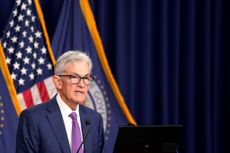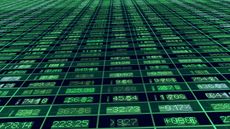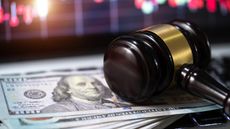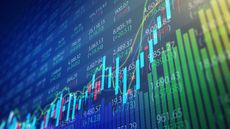Kiplinger Interest Rates Outlook: Pre-election Jitters
Rates rise a bit on nervousness about both presidential candidates’ campaign promises.

Kiplinger’s Economic Outlooks are written by the staff of our weekly Kiplinger Letter and are unavailable elsewhere. Click here for a free issue of The Kiplinger Letter or to subscribe for the latest trends and forecasts from our highly experienced Kiplinger Letter team.
The 10-year Treasury yield ticked up to 4.2% on investor nervousness about looming federal fiscal deficits. The Congressional Budget Office has estimated deficits will average 6% of GDP over the next 10 years under existing tax and spending laws. Both presidential candidates’ campaign promises threaten to cause that number to go higher. That could boost inflation, or at least, cause the Federal Reserve to cut short-term interest rates slower than markets had been expecting. The realities of governing after the election could mean that many of these expensive campaign promises will go unfulfilled, but you should expect long rates to stay above 4.0% until the political situation becomes clearer.
The Federal Reserve will likely still cut its benchmark rate on Nov. 7, but it remains committed to gradualism. Expect future policy meeting cuts to be only a quarter-point each, unless the economy shows worrisome signs of slowing. The Fed’s “Summary of Economic Projections,” which it also released at the Sept. 18 policy meeting, indicates that the Fed is not likely to repeat September’s large cut. The members of the Fed’s policy-making committee indicated that most expected only quarter-point cuts at one or both of the next two meetings, which will take place on Nov. 7 and Dec. 18.

Sign up for Kiplinger’s Free E-Newsletters
Profit and prosper with the best of expert advice on investing, taxes, retirement, personal finance and more - straight to your e-mail.
Profit and prosper with the best of expert advice - straight to your e-mail.
The Fed will cut short-term rates at a steady pace into 2026, but will not return these rates to zero. Figure on the one-month Treasury bill’s yield falling to about 3.0%, and the bank prime rate ending up around 6.0%, down from the current 8.0%, after the Fed is finished reducing its benchmark rate.
The Fed lowered its short-term interest rate by a larger-than-expected 0.5 percentage point on Sept. 18, from 5.25% to 4.75%. Fed Chair Powell offered three reasons during the press conference as to why the cut was so large: “We made a good, strong start because of our confidence [that inflation is coming down];” “We wanted to keep the labor market in good condition;” and "The size of the cut is a sign of our commitment not to get behind." Certainly, a large first cut followed by smaller ones in the future will be judged to be reasonable. And Powell is correct that inflation has been trending down, while there have been signs of modest weakening in the labor market. But, while these factors likely played a part in the decision, it seems that Powell is also still smarting from the criticism the Fed took back in 2022, when they were late to raise interest rates to fight inflation in the first place, and he is determined not to be late on the downside of inflation, as well.
Long-term rates are not likely to fall much as short-term rates come down, because a faster-growing economy could stoke inflation fears among bond investors. There is also the pesky matter of the continuing inverted yield curve, the abnormal situation in which long-term rates are below short rates. Eventually, we expect that the yield curve will revert to upward-sloping, with long-term rates above short-term rates.
The Fed is continuing to reduce its Treasury securities portfolio, even after enacting its half-point rate cut. Powell has emphasized that it is still the Fed’s goal to lower the overall amount of Treasuries and mortgage-backed securities it holds, in order to get its portfolio back to an historically more normal level. This gradual reduction in the Fed’s balance sheet could also push yields on longer-term Treasury bonds a bit higher, since the market will have to soak up more of Washington’s debt, and investors may demand a higher yield to do so.
Declines in mortgage rates stopped with the rise in long-term Treasury yields. But continued progress on lowering inflation next year could result in 30-year fixed rates dipping below 6.0%, and 15-year fixed rates getting close to 5.0%. Mortgage rates are still higher than normal relative to Treasuries, but the eventual Fed cuts in short-term rates will boost banks’ lending margins, which should bring some extra reduction in mortgage rates, too.
Other short-term interest rates will come down at the same pace as the Federal Funds rate. For investors, rates on super-safe money market funds will be slipping below 5%, if they haven’t already. Rates for consumer loans will improve. Rates on home equity lines of credit are typically connected to the prime rate (now 8.0%), which in turn moves with the Federal Reserve’s benchmark rate. Rates on short-term consumer loans such as auto notes will also be affected, with vehicle financing rates going below 7.0% for six-year loans to borrowers with good credit.
Top-rated corporate bond rates have also edged up in tandem with Treasury rates, but low-rated bond rates have continued on a downward path as recession fears fade almost completely. AAA-rated bonds are now yielding around 4.6%, BBB bonds 5.3%, and CCC-rated bond yields are around 11.7%.
Related Content
Get Kiplinger Today newsletter — free
Profit and prosper with the best of Kiplinger's advice on investing, taxes, retirement, personal finance and much more. Delivered daily. Enter your email in the box and click Sign Me Up.

David is both staff economist and reporter for The Kiplinger Letter, overseeing Kiplinger forecasts for the U.S. and world economies. Previously, he was senior principal economist in the Center for Forecasting and Modeling at IHS/GlobalInsight, and an economist in the Chief Economist's Office of the U.S. Department of Commerce. David has co-written weekly reports on economic conditions since 1992, and has forecasted GDP and its components since 1995, beating the Blue Chip Indicators forecasts two-thirds of the time. David is a Certified Business Economist as recognized by the National Association for Business Economics. He has two master's degrees and is ABD in economics from the University of North Carolina at Chapel Hill.
-
 Federal Reserve Meeting: Updates and Commentary
Federal Reserve Meeting: Updates and CommentaryKiplinger experts provide commentary and analysis on the November Federal Reserve meeting.
By Kiplinger Staff Last updated
-
 Market Reaction to Election Results: What the Experts Are Saying
Market Reaction to Election Results: What the Experts Are SayingJobs Report Election uncertainty has been removed from the list of investors' worries, helping equities soar.
By Dan Burrows Published
-
 Federal Reserve Meeting: Updates and Commentary
Federal Reserve Meeting: Updates and CommentaryKiplinger experts provide commentary and analysis on the November Federal Reserve meeting.
By Kiplinger Staff Last updated
-
 Market Reaction to Election Results: What the Experts Are Saying
Market Reaction to Election Results: What the Experts Are SayingJobs Report Election uncertainty has been removed from the list of investors' worries, helping equities soar.
By Dan Burrows Published
-
 Should You Buy Tesla Stock After Trump's Election Win?
Should You Buy Tesla Stock After Trump's Election Win?Shares in Tesla popped on the outcome of the presidential election. Is it time to buy?
By Dan Burrows Published
-
 Two Consequential Tax Cases You May Not Have Heard About
Two Consequential Tax Cases You May Not Have Heard AboutThe Supreme Court's decisions in these cases create uncertainty about challenging IRS regulations and guidance. Expect more litigation to follow.
By John M. Goralka Published
-
 Stock Market Today: Stocks Rise Amid a Broad-Based Election Day Rally
Stock Market Today: Stocks Rise Amid a Broad-Based Election Day RallyAll 11 sectors closed in the green on Tuesday, and all three major indexes added more than 1%.
By David Dittman Published
-
 Stocks Rally on Election Day as Markets Brace for Volatility
Stocks Rally on Election Day as Markets Brace for VolatilityAll three major indexes opened higher as voters chose the 47th President of the United States.
By Dan Burrows Published
-
 Are You an Estate Planning Procrastinator? Where to Start
Are You an Estate Planning Procrastinator? Where to StartQuit putting it off, because it's vital for you and your heirs. From wills and trusts to executors and taxes, here are some essential points to keep in mind.
By Alex Diaz, MBA, CFP® Published
-
 Write a Book in One Day and Become a Best-Selling Author!
Write a Book in One Day and Become a Best-Selling Author!If that sounds like a scam, that's because it is. Online publishing scams entice wannabe authors with big promises for a big price. How to protect yourself.
By H. Dennis Beaver, Esq. Published